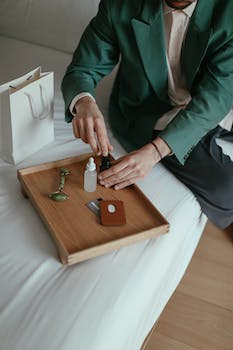

-
Table of Contents
The ultimate guide to bleeding radiators - step-by-step instructions for optimal heating performance.
Introduction
Introduction:
A Step-by-Step Guide to Bleeding a Radiator is a comprehensive manual that provides clear instructions on how to effectively remove trapped air from a radiator system. This guide aims to help homeowners and DIY enthusiasts maintain the efficiency and functionality of their radiators by ensuring proper heat distribution. By following the step-by-step instructions outlined in this guide, individuals can successfully bleed their radiators, improve heating performance, and prevent potential issues such as cold spots or noisy radiators.
The Importance of Regularly Bleeding Your Radiator
A Step-by-Step Guide to Bleeding a Radiator
The Importance of Regularly Bleeding Your Radiator
Maintaining a properly functioning heating system is crucial for a comfortable and warm home. One often overlooked aspect of this maintenance is bleeding your radiators. Over time, air can become trapped in your radiator, preventing it from heating efficiently. This can lead to cold spots in your home and an increase in energy consumption. Regularly bleeding your radiators is a simple yet effective way to ensure they are working at their best.
So, why is it important to bleed your radiators? Well, as mentioned earlier, trapped air can hinder the performance of your heating system. When air accumulates in your radiator, it forms a barrier that prevents the hot water from circulating properly. As a result, the radiator fails to emit heat evenly, leaving certain areas of your home colder than others. By bleeding your radiators, you release this trapped air, allowing the hot water to flow freely and heat your home more efficiently.
Now that we understand the importance of bleeding radiators, let's dive into the step-by-step process. First, you will need a few tools: a radiator key or a flathead screwdriver, a cloth or towel, and a container to catch any water that may escape. It's important to note that before starting this process, you should ensure that your heating system is turned off and has cooled down.
Begin by locating the bleed valve on your radiator. This valve is typically located at the top of the radiator on one of the sides. Once you have found it, place the container beneath the valve to catch any water that may come out. Next, insert the radiator key or screwdriver into the valve and slowly turn it counterclockwise. You should hear a hissing sound as the trapped air escapes. Keep turning until water starts to trickle out. At this point, you can close the valve by turning it clockwise.
After bleeding one radiator, it's important to check the pressure gauge on your boiler. If the pressure has dropped below the recommended level, you may need to top it up. Consult your boiler's manual for instructions on how to do this. Once the pressure is back to normal, you can move on to the next radiator and repeat the process.
It's worth noting that bleeding your radiators should be done on a regular basis, especially before the colder months when you rely heavily on your heating system. By bleeding your radiators at least once a year, you can ensure that they are working efficiently and effectively. This simple maintenance task can save you money on energy bills and keep your home warm and comfortable throughout the winter.
In conclusion, bleeding your radiators is an essential part of maintaining a well-functioning heating system. By releasing trapped air, you allow hot water to circulate freely, ensuring that your radiators heat your home evenly. With a few simple tools and a step-by-step process, you can easily bleed your radiators and keep your home warm and cozy. So, don't forget to include this important task in your regular maintenance routine.
Step-by-Step Instructions for Bleeding a Radiator

A Step-by-Step Guide to Bleeding a Radiator
If you have noticed that your radiator is not heating up properly or that there are cold spots on it, it may be time to bleed it. Bleeding a radiator is a simple process that can help improve its efficiency and ensure that your home stays warm during the colder months. In this article, we will provide you with a step-by-step guide on how to bleed a radiator.
Step 1: Turn off the heating system
Before you start bleeding the radiator, it is important to turn off the heating system. This will prevent any hot water from flowing through the radiator while you are working on it. You can do this by turning off the boiler or the central heating system.
Step 2: Locate the bleed valve
The next step is to locate the bleed valve on the radiator. The bleed valve is usually located at the top of the radiator and is a small square or hexagonal nut. You may need to use a radiator key or a flathead screwdriver to open the valve.
Step 3: Prepare a container
To catch any water that may come out of the radiator, it is important to prepare a container. This can be a bucket or a towel placed on the floor beneath the radiator. Make sure that the container is large enough to hold the water that will be released.
Step 4: Open the bleed valve
Using the radiator key or screwdriver, slowly turn the bleed valve anticlockwise. You will hear a hissing sound as the air escapes from the radiator. Keep turning the valve until water starts to come out. Be careful not to open the valve too quickly, as this can cause water to spray out.
Step 5: Close the bleed valve
Once water starts to come out of the bleed valve, it is time to close it. Use the radiator key or screwdriver to turn the valve clockwise until it is fully closed. Be careful not to overtighten the valve, as this can cause damage.
Step 6: Check the pressure
After bleeding the radiator, it is important to check the pressure in the heating system. You can do this by looking at the pressure gauge on the boiler or the central heating system. If the pressure is too low, you may need to top it up using the filling loop or consult a professional.
Step 7: Turn on the heating system
Once you have completed bleeding the radiator and checked the pressure, it is time to turn on the heating system again. This will allow hot water to flow through the radiator and ensure that it is working properly. You should now notice that the radiator heats up evenly and that there are no cold spots.
In conclusion, bleeding a radiator is a simple process that can help improve its efficiency and ensure that your home stays warm. By following these step-by-step instructions, you can easily bleed a radiator and keep your heating system in top condition. Remember to always turn off the heating system before starting and to be careful when opening and closing the bleed valve.
Common Mistakes to Avoid When Bleeding a Radiator
Common Mistakes to Avoid When Bleeding a Radiator
Bleeding a radiator is a simple task that can help improve the efficiency of your heating system. However, there are some common mistakes that people often make when attempting to bleed their radiators. In this section, we will discuss these mistakes and provide you with tips on how to avoid them.
One of the most common mistakes is not turning off the heating system before bleeding the radiator. This can lead to hot water spraying out of the radiator and potentially causing burns. To avoid this, always make sure to turn off the heating system and allow the radiator to cool down before attempting to bleed it.
Another mistake that people often make is not using the correct tools. To properly bleed a radiator, you will need a radiator key or a flathead screwdriver, depending on the type of valve your radiator has. Using the wrong tool can damage the valve and make it difficult to bleed the radiator effectively. Therefore, it is important to ensure that you have the right tool before starting the process.
One mistake that can lead to a messy situation is not placing a towel or bucket underneath the radiator valve. When you open the valve to bleed the radiator, water or air may come out, and without a towel or bucket to catch it, you could end up with a wet and slippery floor. To avoid this, always place a towel or bucket underneath the valve to catch any liquid that may escape.
Another common mistake is not bleeding the radiator fully. Sometimes, people stop bleeding the radiator as soon as they see water coming out. However, it is important to continue bleeding until all the air has been released and only water is flowing. Failing to do so can result in trapped air remaining in the radiator, which will reduce its efficiency.
One mistake that can cause damage to your heating system is over-tightening the radiator valve after bleeding. It is important to remember that the valve only needs to be tightened enough to stop any water or air from escaping. Over-tightening can damage the valve and cause leaks. Therefore, it is crucial to be gentle when tightening the valve and to stop as soon as you feel resistance.
Lastly, one common mistake that people make is not checking the pressure gauge on their boiler after bleeding the radiator. Bleeding a radiator can sometimes cause a drop in pressure, and if the pressure is too low, it can affect the performance of your heating system. Therefore, always check the pressure gauge and, if necessary, top up the pressure to the recommended level.
In conclusion, there are several common mistakes that people often make when bleeding a radiator. These include not turning off the heating system, using the wrong tools, not placing a towel or bucket underneath the valve, not bleeding the radiator fully, over-tightening the valve, and not checking the pressure gauge. By avoiding these mistakes and following the correct procedure, you can ensure that your radiator is properly bled and your heating system operates efficiently.
Q&A
1. What is the purpose of bleeding a radiator?
The purpose of bleeding a radiator is to release trapped air that can prevent the radiator from heating up properly.
2. How often should radiators be bled?
Radiators should be bled whenever they feel cold at the top while the bottom is warm. This can occur once or twice a year, depending on the system.
3. What are the steps to bleed a radiator?
To bleed a radiator, you will need a radiator key. Start by turning off the heating system, locate the bleed valve on the radiator, insert the key into the valve, and slowly turn it counterclockwise. You will hear a hissing sound as the air escapes. Once water starts to come out, close the valve and check for any leaks.
Conclusion
In conclusion, a step-by-step guide to bleeding a radiator is a helpful resource for individuals looking to maintain their heating systems. By following the outlined steps, one can effectively remove trapped air from the radiator, ensuring optimal heating performance. Regularly bleeding radiators can improve energy efficiency and prevent potential issues with the heating system.












